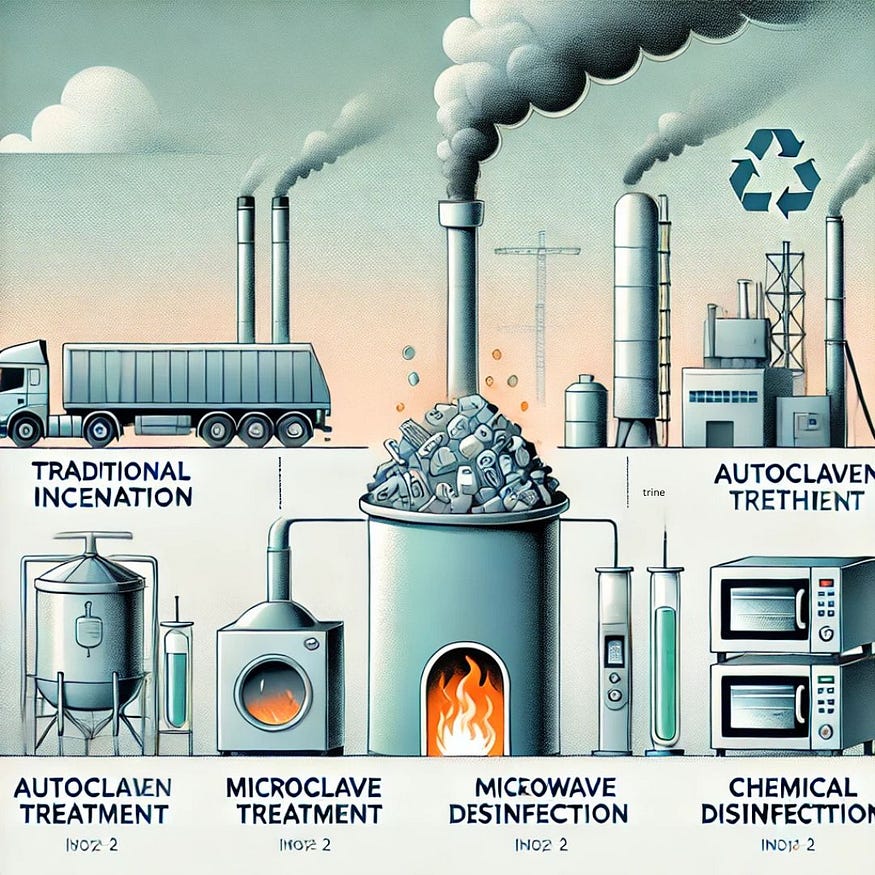Incinerators in Kerala: Are There Better Alternatives for Medical Waste Disposal?

Introduction
Medical waste disposal is a critical issue in Kerala, where healthcare facilities generate significant amounts of hazardous waste daily. Traditionally, incinerators in Kerala have been the primary method for managing medical waste. However, concerns about air pollution and environmental damage have led to the exploration of alternative solutions. This article examines incineration, its drawbacks, and eco-friendly alternatives for handling medical waste.
The Role of Incinerators in Kerala
Incineration has been widely used in Kerala to manage biohazardous waste, particularly from hospitals, clinics, and laboratories. The process involves burning waste at high temperatures, effectively destroying pathogens and reducing waste volume. However, despite its efficiency, incineration has several drawbacks:
Disadvantages of Incineration
- Air Pollution — Incineration releases harmful pollutants like dioxins, furans, and particulate matter, contributing to respiratory issues and environmental degradation.
- High Operational Costs — Running an incinerator requires substantial energy and maintenance, increasing waste disposal expenses.
- Ash Disposal Issues — The residual ash often contains toxic heavy metals, requiring proper landfill management to prevent contamination.
- Regulatory Challenges — Strict environmental norms limit the expansion and operation of incinerators in Kerala.
Alternatives to Incineration for Medical Waste Disposal
With growing concerns about pollution and sustainability, several eco-friendly medical waste disposal methods are gaining popularity in Kerala:
1. Autoclaving
Autoclaving uses steam sterilization to disinfect medical waste before disposal. It is an effective and safer alternative to incineration.
- Advantages:
- No toxic emissions
- Energy-efficient
- Cost-effective for healthcare facilities
- Limitations:
- Not suitable for all types of medical waste (e.g., chemical and pharmaceutical waste)
2. Microwave Treatment
This method uses high-frequency microwave radiation to sterilize waste, effectively killing pathogens.
- Advantages:
- Reduces infectious risks
- Environmentally friendly
- Lower operational costs than incineration
- Limitations:
- Requires specialized equipment
- Ineffective for chemical or pharmaceutical waste
3. Chemical Disinfection
Chemical agents like chlorine compounds can neutralize biohazardous waste before disposal.
- Advantages:
- Can treat liquid waste
- Suitable for laboratory and pharmaceutical waste
- Limitations:
- Potential chemical residue
- May require additional handling procedures
4. Plasma Gasification
A cutting-edge technology that converts waste into syngas (synthetic gas) using high-energy plasma.
- Advantages:
- Minimal emissions
- Converts waste into energy
- Limitations:
- High initial investment
- Requires advanced infrastructure
5. Pyrolysis
This process decomposes medical waste in a low-oxygen environment to produce biochar and syngas.
- Advantages:
- Reduces landfill dependency
- Can generate energy from waste
- Limitations:
- Not widely available in Kerala
- Expensive technology
The Future of Medical Waste Management in Kerala
As environmental regulations become stricter and awareness grows, Kerala must adopt sustainable medical waste disposal methods. While incinerators in Kerala continue to play a role, transitioning to greener technologies like autoclaving, microwave treatment, and plasma gasification can significantly reduce pollution and enhance public health.
Conclusion
The reliance on incinerators in Kerala for medical waste disposal is gradually shifting towards eco-friendly alternatives. Government support, technological advancements, and stricter pollution controls will drive this transition. By adopting cleaner waste management solutions, Kerala can lead the way in sustainable healthcare waste disposal.

Comments
Post a Comment